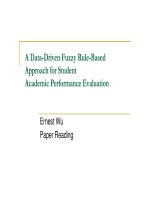Fuzzy relation Fuzzy relation
Bạn đang xem bản rút gọn của tài liệu. Xem và tải ngay bản đầy đủ của tài liệu tại đây (157.72 KB, 35 trang )
Fuzzy relation
If U is the Cartesian product of n universes of
discourse U1,…, Un, that is, U=U1 x…x Un, then
an n-array fuzzy relation, R, in U is a fuzzy
subset of U and is defined is
R R (u1,..., un ) /(u1,..., un )
R (u1 ,..., u n )
,where
function R
is the membership
Example : Consider U1 U 2 ( ,) Define the
relation “close to” by e u1 u2 /(u1 , u2 )
u1 xu 2
where is a scalar factor. Similarly, for
u1 than
the 2relation
U1, U
1,2,3“,4 is much greater
u2 by the relation matrix
can be defined
R
1
2
3
4
1 2
3
4
0 0.3 0.8 1
0 0 0.3 0.8
0 0 0 0.3
0 0
0 0
”
Or, equivalently,
0.0 0.3 0.8 1.0
0.0 0.0 0.3 0.8
R= 0.0 0.0 0.0 0.3
0.0 0.0 0.0 0.0
Or we can use a table (called fuzzy matrix) to
define the relation, instead of a algebraic
function
Ex: Let V x1 , x2 , x3 , Y y1 , y2 , y3 , y4
R= “x is considerably larger than y”
y1
y2
x1
0.8 1
x2
0
y3
0.1 0.7
0.8 0
X3 0.9 1
y4
0
0.7 0.8
Z= “y is very close to x”
Fuzzy matrix
y1
y2
y3
y4
x1
0.4 0
0.9 0.6
x2
0.9 0.4 0.5 0.7
X3
0.3 0
0.8 0.5
Operations of Relations
Union
R Z ( x, y ) Max R ( x, y ), Z ( x, y ) where ( x, y ) V xY
Intersection
R Z ( x, y ) Min R ( x, y ), Z ( x, y ) where ( x, y ) X xY
Complement
Contained
B ( x, y ) 1 B ( x, y )
R Z R ( x , y ) Z ( x , y )
y1
RZ
RZ
y2
y3
y4
x1
0.8 1
x2
0.9 0.8 0.5 0.7
X3
0.9 1
0.8 0.8
y1
y3
y2
x1
0.4 0
x2
0
X3
0.3 0
0.9 0.7
y4
0.1 0.6
0.4 0
0
0.7 0.5
Converse
R 1
R 1 ( y , x ) R ( x , y )
Identity relation
1 x y
I ( x, y ) if
0 x y
Z ( x, y ) 0 x X , y Y
Null relation Z
Z ( x, y ) 1 x X , y Y
Universal relation U
Superstar Composition ROS =
x, z , sup
R
( x, y ) * s ( y , z ) | x X , y Y , z Z
Composition of Fuzzy Relations *:can be any of TNorm
Max - Min Composition
Let R1 ( x, y ) ( x, y ) X xY and
R2 ( y , z ) ( x, y ) Y x Z be two fuzzy relation
The max - min composition R1 maximin R2 is the fuzzy relation
R10 R2 ( x, z ), max min R ( x, y ), R 2 ( y , z ) | x X , y Y
y
max
max - product
R10 R2 ( x, z ), max R1 ( x, y ), R 2 ( y , z ) | x X , y Y
y
max - average Composition
1
R10 R2 ( x, z ), max R1 ( x, y ) R 2 ( y, z ) | x X , y Y
2
Linear alegbra R1xR2 ( x, z ) sup R1 n ...
Property of the Max-Min Composition
Associatively
Reflectivity
( R3 R2 ) R1 R3 ( R2 R1 )
Let R be a fuzzy relation in X x X
R is called reflexive if R ( x, x) 1 x X
E reflective R ( x, x) x X 0 1
Symmetry
R( x, y ) R ( y, z ) R 1 ( x, y )
VARIOUS TYPES OF BINARY
FUZZY RELATIONS
Various important types of binary fuzzy relations
are distinguished on the basis of three different
characteristic properties: reflexivity, symmetry,
and transitivity.
A fuzzy relation R(X,X) is reflexive if and only if
R x, x 1 for all x X .
(3.29)
Symmetry
A fuzzy relation R(X,X) is symmetric if and only if
R x , y R y , x
for all x X .
(3.30)
If it is not satisfied for some x,yX, then the relation is c
alled asymmetric. If the equality is not satisfied for all m
embers of the support of the relation, then the relation is
called antisymmetric. If Eq. (3.30) is not satisfied for all
x,yX, then R(X,X) is called strictly antisymmetric.
Antisymmetric
if for x y either R ( x, y ) R ( y, x)
or R ( x, y ) R ( y, x) 0 x, y X
Transitivity
A fuzzy relation R(X,) is transitive (or, more speci
fically, max-min transitive and only if
R x, z max min R x, y , R y, z
yY
for all x, z X 2 .
(3.31)
If this is not true for some members of X,R(X,X) i
s called nontransitive. If the inequality of Eq. (3.3
2
x
,
z
X
1) does not hold for all
, then R(X,X) is c
alled antitransitive.
Transitivity
The max-min transitive can be generalized to alt
ernative transitives by replacing the min operator
with any t-norm. For example, using the algebrai
c product, we obtain the max product transitive w
hich is defined by
R x, z max min R x, y R y, z
yY
for all x, z X 2 .
(3.32)
Quiz
Please specify the following examples of fuzzy
relations satisfying which properties mentioned
above.
1
Ra 0.3
0.4
1
Rd 0.1
0.5
0.8 0.3
0.3
1 0.6 , Rb 0
0 1
0.5
0 0.6
1
0.3 0.8 , Re 0
0 0.5
0.5
1
0.9
1
0.7 0.2 , Rc = 0.5
0 0.3
0.7
0 0.6
0.1
0.7 0.2 , R f = 0
0 0.3
0
0.5
0.3
0.1
0.5
1
0.3
0.7
0.1 ,
0
0.7
0.2 .
0.2
Answers:
It is clear that Ra is reflexive, Rb is antireflexive,
Rc is symmetric, Rd is antisymmetric, Re is strictly
antisymmetric, and Rf is transitive. The fuzzy rela
tion in Rf is transitive because
0.1 0.5 0.7 0.1 0.5 0.2
R f = 0 1 0.2 0 1 0.2 R f oR f
0 0.3 0.2 0 0.3 0.2
Transitive closure
The transitive closure of a fuzzy relation R(X,X) is denoted
by RT(X,X);
it is a fuzzy relation that is transitive and contains R(X,X),
and its elements have the smallest possible membership
grades. When X has n elements, the transitive closure
RT(X,X) can be obtained by
RT X , X R U R 2 UL U R n , where R i R i 1 oR, i 2. (3.33)
R n R n 1
Example 3.15
Let X x1 , x2 , x3 and let a fuzzy relation R( X , X ) be given as
0.1 0.5 0.2
R 0.4 0.7 0.8
0 0.1 0.4
Then the fuzzy closure of R can be obtained as follows:
0.4 0.5 0.5
0.4
R 2 R oR 0.4 0.7 0.7 , R 3 0.4
0.1 0.1 0.4
0.1
0.4 0.5
RT X , X R U R 2 U R 3 0.4 0.7
0.1 0.1
0.5 0.5
0.7 0.7 ,
0.1 0.4
0.5
0.8 .
0.4
Fuzzy Relation Equation
Let A be a fuzzy set in X and R(X,Y) be a binary fuzzy r
elation in X x Y. The set-relation composition of A and R 。
A, results in a fuzzy set in Y.
Let us denote the resulting fuzzy set as B. Then we hav
e A 。 R=B, whose membership functionis
B y AoR Y max min A x , R x, y . (3.48)
xX
Example 3.21
Given a fuzzy set A in X and a fuzzy relation R in X
X Y as follows,
x1
x2
x3
A 0.2 x1 0.8 x 2 1 x 3 0.2 0.8 1 ,
x1
R= x2
y1
0.7
0.5
0.2
y2
1
0.9
0.6
y3
0.4
0.6
0.3
x3
y1
x1 0.7
x1 x2 x3
B = A 。 R=(0.2 0.8 1) 。 x2 x0.5
3
0.2
0.5 y1 0.8 y2 0.6 y3 .
y2 y3
y 1 y 2 y3
1 0.4
0.9 0.6 = (0.5 0.8 0.6)
0.6 0.3
Next, we shall study the following more difficult problems:
Fuzzy Input
A
Fuzzy System
R
Fuzzy Output
B
Figure 3.5 Fuzzy system with fuzzy input and fuzzy output.
Next, we shall study the following more difficult problems:
P1: Given A and B, determine R such that A 。 R =B.
P2: Given R and B, determine A such that A 。 R =B.
Theorem 3.1
Problem P1 has solution(s) if and only if the height of the
fuzzy set A is greater than or equal to the height of the
fuzzy set B, that is,
max A ( x ) B ( y ) for all y Y
xX
In order to solve problem P1 (and problem P2 later), we
need to introduce the -operation. For any a, b﹝0,1﹝,
the -operator is defined as
1
if a b.
(3.50)
a b
b
if a b.
For fuzzy sets A and B in X and Y, respectively, the
-composition of A and B forms a fuzzy relation A
srB
in X x Y which is defined by
AsuBur x, y A x B y
1
B y
if A ( x ) B y
if A ( x ) B y
Furthermore, the -composition of a fuzzy relation R and a
fuzzy set B is denoted by R
srB and is defined by
RsuBur x min R x, y B y .
yY
With the above -composition, the following properties will
be useful for determining the solutions of problem P1.









